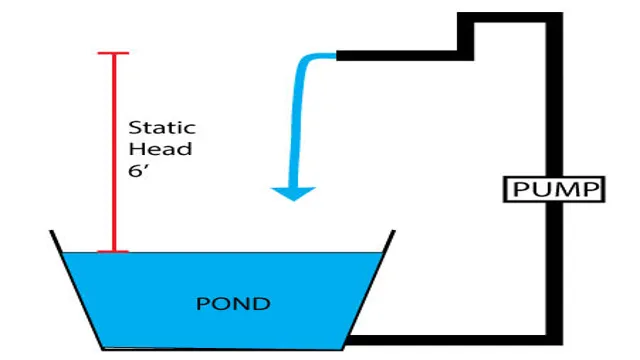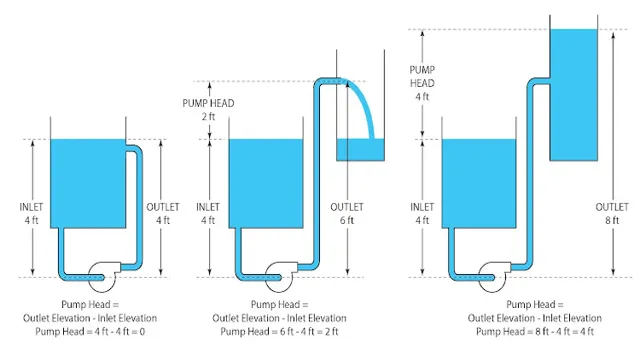Are you struggling with understanding how to calculate head pressure for your aquarium pump? Look no further! Understanding head pressure is an essential part of maintaining a healthy environment for your fish and aquatic plants. In simple terms, head pressure is the amount of resistance the water must overcome as it is pumped through your aquarium system. It is crucial to ensure that your pump has enough power to overcome this resistance and provide adequate water flow throughout your filtration system.
Imagine trying to climb a steep hill – you need enough energy to overcome the resistance and reach the top. The same applies to your aquarium pump! Join us as we explore the ins and outs of calculating head pressure and how it can make all the difference in the health and happiness of your aquatic friends.
What is Head Pressure?
Calculating head pressure for your aquarium pump is important to ensure proper water flow and circulation. Head pressure is the resistance that the pump has to overcome to move water from the aquarium into the filtration system and back. It is affected by the height and distance between the aquarium and filtration system, the tubing diameter, and the equipment used for filtration.
It is calculated by adding the vertical distance from the water level in the aquarium to the water level in the filtration system, as well as the horizontal distance and friction losses from tubing or equipment. This information is important when selecting the appropriate pump for your aquarium system to ensure optimal water flow and healthy aquatic life. So, make sure to calculate the head pressure before investing in an aquarium pump to avoid any potential issues.
Definition and Importance
Head pressure is a term used to describe a feeling of pressure or heaviness in the head. It can be caused by a variety of factors such as stress, tension headaches, sinus problems, or more serious conditions like migraines or brain tumors. This sensation can be accompanied by other symptoms such as dizziness, nausea, or a feeling of tightness around the forehead and temples.
Head pressure can be a significant concern, and it’s essential to seek medical advice if the condition persists or is severe. Ignoring it could lead to more serious problems in the long run. Therefore, it is crucial to ensure that you take care of yourself to avoid such an occurrence.
Adequate rest, exercise, and a balanced diet are all essential to maintaining good physical and mental health and preventing head pressure.

Factors Affecting Head Pressure
When it comes to calculating head pressure for aquarium pumps, there are several factors to consider. The diameter of the tubing, the height of the tank, the type of filter being used, and even the number of bends in the piping can all affect the head pressure. A high head pressure can lead to reduced flow rate and strain on the aquarium pump.
It’s important to ensure that the pump you choose can handle the head pressure in your system. To calculate head pressure, you can use various online calculators or consult with an expert in aquatic systems. Understanding the factors that influence head pressure can help you make informed decisions when choosing aquarium equipment.
Remember that investing in a pump that can handle the head pressure in your system can save you money in the long run by reducing wear and tear on your equipment and preventing unnecessary repairs.
Pipe Diameter, Length, and Flow Rate
When it comes to plumbing, head pressure is a critical factor to consider. Head pressure refers to the resistance that water faces as it moves through your pipes, and several factors can affect it. One such factor is the diameter of the pipe.
The wider the pipe, the less resistance the water will face, resulting in lower head pressure. Length is another factor to consider. The longer the pipe, the more head pressure there will be. (See Also: How to Make Your Own Aquarium Wood: A Step-by-Step Guide to Customizing Your Aquatic Habitat)
Lastly, the flow rate, or the amount of water being pushed through the pipe, can also impact head pressure. Higher flow rates mean increased head pressure. Understanding these different factors and how they impact head pressure can help ensure your plumbing system runs smoothly and efficiently.
Make sure to keep these things in mind when planning the layout and design of your plumbing system.
Height Difference and Frictional Losses
Head Pressure When it comes to pumping fluids through pipes, the height difference between the source and the destination plays a vital role in calculating the head pressure required for the process. Head pressure is the pressure required to move fluids from one location to another. The greater the height difference, the higher the head pressure needed to overcome the force of gravity.
In addition to the height difference, frictional losses in the pipe also affect the head pressure calculation. As fluid flows through a pipe, it encounters friction against the walls of the pipe, which results in a loss of energy. This loss of energy equates to a decrease in the head pressure, making it essential to factor in frictional losses when determining the appropriate head pressure for efficient fluid flow.
It’s crucial to understand these factors and calculate head pressure accurately to ensure that fluid flows efficiently and effectively while avoiding any potential damage to pipes and equipment.
How to Calculate Head Pressure
If you’re setting up an aquarium, you’ll need to install a pump to circulate the water. However, it’s important to make sure that the pump is powerful enough to overcome the resistance of the filter system and ensure the right flow rate for your tank. To do this, you’ll need to calculate the pump’s head pressure.
Head pressure is the amount of force that the pump needs to generate to push water through the tubing and up to the top of the tank. To calculate head pressure for aquarium pumps, you’ll need to consider the pump’s flow rate, the height of the water column, the length and diameter of the tubing, and the resistance of the filter media and any other obstacles in the system. By measuring and calculating these factors, you can determine the minimum head pressure required for your pump and choose the right model for your aquarium system’s needs.
Step-by-Step Instructions with Formula
If you are looking to calculate head pressure, the process is fairly straightforward. Head pressure refers to the amount of pressure that a fluid exerts on a surface. To calculate head pressure, you will first need to determine the height of the fluid in the container.
Once you have this measurement, you can then use a simple formula to calculate the head pressure. The formula is: Head Pressure = Height of fluid x Specific gravity of fluid x 0.43
The specific gravity of the fluid is a measure of its density compared to water. The 0.433 factor is a constant that converts pounds per square inch (psi) to feet of head pressure.
By using this formula, you can easily calculate the head pressure of any liquid. So, the next time you need to measure the head pressure of a fluid, you now have the tools to do so accurately and efficiently. (See Also: How to Build a Wood Stand for 60 Gal Aquarium: Step-by-Step Guide)
Example Calculation
Calculating head pressure for aquarium pumps is an important step in creating the perfect environment for your fish. This measurement determines how high the pump can push water and is critical in ensuring water flow through filters and other aquarium accessories. To calculate head pressure, start by measuring the vertical height from the pump to the highest point of your aquarium.
Then, measure the length of the tubing and the number of fittings and bends in the system. These measurements will determine the friction loss in the system. Finally, use a head pressure calculator or formula to combine the vertical height and friction loss to get the total head pressure required.
By correctly calculating head pressure, you can ensure the proper flow of water through your aquarium and keep your fish and aquatic plants healthy and happy.
Scenario with Specific Data
Let’s take a look at an example calculation to better understand how specific data can impact different scenarios. Say we have a retail store that sells clothing, and we want to analyze our sales data from the past year to determine which products are the most popular. We examine our records and find that our highest-selling category is t-shirts, specifically those with graphic designs.
Next, we dive deeper and look at the specific designs that have sold the most. We find that shirts featuring cat designs have been extremely popular, selling over 3,000 units in the past year. Armed with this knowledge, we can now make informed decisions about our product inventory.
For example, we may want to increase our stock of both t-shirts and cat-themed designs, as these have proven to be our bestsellers. We may also opt to create more designs featuring cats to capitalize on this trend. As you can see, specific data can be incredibly valuable in making informed business decisions.
By analyzing our sales data in depth, we can better understand our customers’ preferences and adjust our strategy accordingly. This type of analysis can be applied to a wide range of industries and scenarios, so it’s always worth taking the time to dive deep into your data.
Conclusion
In short, calculating head pressure for aquarium pumps is all about understanding the factors that affect water flow and utilizing the right equations to determine the required pressure. Don’t let the calculations intimidate you – with a little patience and a bit of math, you’ll be able to keep your aquatic friends happily swimming along in their perfectly pressurized oasis. Just remember, there’s no need to feel like a fish out of water when it comes to calculating head pressure!”
Summary and Additional Tips
Let’s take a look at an example calculation to understand the concept of burstiness in more depth. Suppose we have a dataset of 1000 words, and we want to calculate the burstiness of the word “dog.” Upon counting the total number of occurrences of the word “dog” in the dataset, we find that it appears 50 times.
Now, let’s assume that the total number of occurrences of all other words in the dataset is 950. To calculate the burstiness, we can use the formula (B – M) / (B + M – A), where B represents the total number of occurrences of the word in question, M represents the average number of occurrences of the word across all chunks of the dataset, and A represents the average number of occurrences of all other words in the dataset. Using this formula, the burstiness of the word “dog” in our dataset would be (50 – (950 / 1000)) / (50 + (950 / 1000) – (950 / 1000)), which simplifies to 0.
47 This means that the word “dog” is relatively bursty in our dataset, indicating that it appears frequently in short bursts rather than being spread out evenly across the dataset. To improve our understanding further, we could repeat this calculation for other words and compare their burstiness values. (See Also: How to Clean Outside Rocks for Aquarium: Easy Tips and Tricks)
By examining the burstiness of different words, we can gain insights into patterns in the text and how different words are used within it.
FAQs
What is head pressure in aquarium pumps?
Head pressure is the measure of how high a pump can push water vertically against gravity.
Why is head pressure important in aquarium pumps?
Head pressure is important in aquarium pumps as it determines the pump’s capacity to move water up to the desired height in aquariums.
How can I calculate head pressure for my aquarium pump?
To calculate head pressure for an aquarium pump, measure the vertical height between the water level in the aquarium and the output of the pump, and multiply this by 0.433.
What are the factors that affect head pressure in aquarium pumps?
Factors that affect head pressure in aquarium pumps include the vertical height of the water column, the diameter of the tubing used, and the flow rate of the pump.
How does head pressure affect the flow rate of aquarium pumps?
Head pressure can reduce the flow rate of aquarium pumps as it restricts the pump’s ability to push water up to a certain height.
Can adding a second pump increase head pressure in an aquarium?
Yes, adding a second pump can increase head pressure in an aquarium by dividing the total vertical height between the two pumps.
How often should I check the head pressure of my aquarium pump?
It is recommended to check the head pressure of your aquarium pump regularly, at least once a month, to ensure that it is operating at optimal levels.







